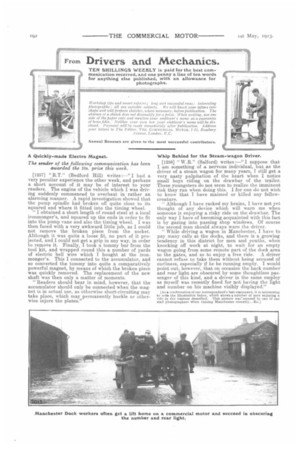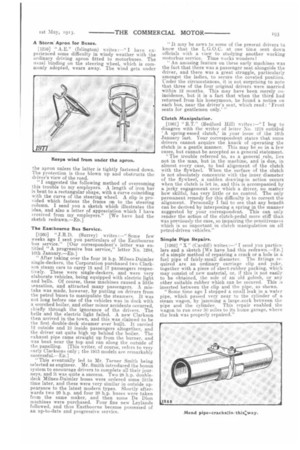From Drivers and Mechanics.
Page 24

Page 25

If you've noticed an error in this article please click here to report it so we can fix it.
TEN SHILLINGS WEEKLY is paid for the best communication received, and one penny a line of ten words for anything else published, with an allowance for photographs.
Workshop tips and smart reNirs; long and successful runs: interesting photographs ; all are suitable subjects. We will knock your letters into shape and will prepare sketches, where necessary, before publication. The absence oi a sketch does not disqualify for a Prize. When writing, use one side of the paper only and mention your employer's name as a kligrantee of bona fides. Neither your own nor your employer's name will be disclosed. Payment will be made immediately after Publication. Address your letters to The Editor, THE COUNIERCIAL Moroi?, 7-n, Rosebery
Avenue, London, E.C.
Annual Bonuses are given to the most successful contributors.
A Quickly-made Electro Magnet.
The sender of the following communication has been awarded the 10s. prize this week.
[1257] "R.T." (Bedford Hill) writes :—" I had a very peculiar experience the other week, and perhaps a short account of it may be of interest to your readers. The engine of the vehicle which I was driving suddenly commenced to overheat in rather an alarming manner. A rapid investigation showed that the pump spindle had broken off quite close to its squared end where it fitted into the timing wheel. " I obtained a short length of round steel at a local ironmonger's, and squared up the ends in order to fit into the pump vane and also the timing wheel. I was then faced with a very awkward little job, as I could not remove the broken piece from the socket. Although it was quite a loose fit, no part of it projected, and I could not get a grip in any way, in order to remove it. Finally, I took a tommy bar from the tool kit, and wrapped round this a number of yards of electric bell wire which I bought at the ironmonger's. This I connected to the accumulator, and so converted the tornrny into quite a comparatively powerful magnet, by means of which the broken piece was quickly removed. The replacement of the new shaft was then only a matter of moments.
"Readers should bear in mind, however, that the accumulator should only be connected when the magnet is in actual use, as otherwise short-circuiting may take place, which may permanently buckle or otherwise injure the plates."
Whip Behind for the Steam-wagon Driver.
[1258] " W.R." (Salford) writes :—" I suppose that I am something of a nervous individual, but as the driver of a steam wagon for many years, I still get a very nasty palpitation of the heart when I notice small boys riding on the drawbar of the trailer. These youngsters do not seem to realize the imminent risk they run when doing this. I for one do not wish to know that I have maimed or killed any fellowcreature.
"Although I have racked my brains, I have not yet thought of any device which will warn me when someone is enjoying a risky ride on the drawbar. The only way I have of becoming acquainted with this fact is by gazing into passing shop windows. Of course the second man should always warn the driver.
"While driving a wagon in Manchester, I have to pay many calls at the docks, and there is a growing tendency in this district for men and youths, when knocking off work at night, to wait for an empty wagon going from some remote part of the dock area to the gates, and so to enjoy a free ride. A driver cannot refuse to take them without being accused of surliness, especially if he be running empty. I would point out, however, that on occasion the back number and rear light are obscured by some thoughtless passenger of this kind, and a driver in the same employ as myself was recently fined for not having the light and number on his machine visibly displayed."
IA, a confirmation of our correspondent's last statement, it is interesting to note the illustration below, which shows a number of men enjoying a ride in the manner described. This picture was-secured by one of our stall photographers when visiting Manchester recently—En.] A Storm Apronfor Buses.
[1259] " A.E." (Islington) writes:—" I have experienced some difficulty in windy weather with the ordinary driving apron fitted to motorbuses. The usual binding on the steering wheel, which is commonly adopted, wears away. The wind gets under
the apron unless the latter is tightly fastened down. The protection is thus blown up and obstructs the driver's view of the road.
"I suggested the following method of overcoming this trouble to my employers. A length of iron bar is bent to a rectangular shape, with a curve coinciding with the curve of the steering wheel. A clip is provided which fastens the frame on to the steering column. I send you a sketch which illustrates the idea, and also a letter of appreciation which I have received from my employers." [We have had the sketch redrawn.—En.]
The Eastbourne Bus Service.
[1260] " J.R.D. (Surrey) writes :—" Some few weeks ago I sent you particulars of the Eastbourne bus service." [Our correspondent's letter was entitled "A progressive bus service," letter No. 1204, 16th January.—En.] "After taking over the four 16 h.p. Milnes-Daimler single-deckers, the Corporation purchased two Clarkson steam cars to carry 15 and 17 passengers respectively. These were single-deckers, and were very elaborate vehicles, being equipped with electric light and bells. Of course, these machines caused a little sensation, and attracted many passengers. A mistake was made, however, by putting on drivers from the petrol buses to manipulate the steamers. It was not long before one of the vehicles was in dock with a scorched boiler, and other minor accidents occurred, chiefly through the ignorance of the drivers. The bells and the electric light failed_ A new Clarkson then arrived in the town, and this was claimed to be the first double-deck steamer ever built. It carried 12 outside and 10 inside passengers altogether, and the driver sat quite high up behind the boiler. The exhaust pipe came straight up from the burner, and was bent near the top and ran along the outside of the panelling. [This writer, of course, refers to very early Clarksons only ; the 1913 models are remarkably successful—En.]
"This eventually led to Mr. Turner Smith being selected as engineer. Mr. Smith introduced the bonus system to encourage drivers to complete all their journeys, and it was quite a success. Two 28 h.p. doubledeck 3/filnes-Daimler buses were ordered some little time later, and these were very similar in outside appearance to the latest modern types. Shortly afterwards two 20 h.p. and four 30 h.p. buses were taken from the same maker, and then some De Dion machines were purchased. Four fine new Leylands followed, and thus Eastbourne became possessed of an up-to-date and progressive service. "It may be news to some of the present drivers to know that the L.G.O.C. at one time sent down officials with a view to studying another working motorbus service. Time works wonders I "An amusing feature on these early machines was the fact that there was a passenger seat alongside the driver, and there was a great struggle, particularly amongst the ladies, to secure the coveted position. Under the circumstances, it is not surprising to note that three of the four original drivers were married within 12 months. This may have been merely coincidence, but it is a fact that when the third had returned from his honeymoon, he found a notice on each bus, near the driver's seat, which read: 'Front seats for gentlemen only.'" Clutch Manipulation.
[1261] "R.T." (Bedford Hill) writes:—" I be to disagree with the writer of letter No. 1218 entitled 'A spring-eased clutch,' in your issue of the 16th January last. Your correspondent states that some drivers cannot acquire the knack of operating the clutch in a gentle manner. This may be Bo in a few cases, but cannot be accepted as a general statement.
"The trouble referred to, as a general rule, lies not in the man, but in the machine, and is due, in almost every case, to bad alignment of the clutch with the flywheel. When the surface of the clutch is not absolutely concentric with the inner diameter of the flywheel, a sudden drawing-in action occurs when the clutch is let in, and this is accompanied by a jerky engagement over which a driver, no matter how skilful, has very little or no control. The only permanent remedy for this difficulty is to correct the alignment. Personally I fail to see that any benefit can be derived by interposing a spring in the manner suggested by your correspondent. This can only render the action of the clutch-pedal more stiff than was previously the case, so impairing the sensitiveness which is so important in clutch manipulation on all petrol-driven vehicles."
Simple Pipe Repairs.
[1262] " X" (CardifT) writes :—" I send you particulars and a sketch [We have had this redrawn.—En.] of a simple method of repairing a crack or a hole in a fuel pipe of fairly-small diameter. The fittings required are an ordinary carriage clip and yoke, together with a piece of sheet-rubber packing, which may consist of new material, or, if this is not easily to be obtained, the sole of an old golosh, or any other suitable rubber which can be secured. This inserted between the clip and the pipe, as shown.
"Some time ago I stopped a small leak in a water pipe, which passed very near to the cylinder of a steam wagon, by jamming a, large -cork between the pipe and the cylinder. This repair enabled the wagon to run over 30 miles to its home garage, where the leak was properly repaired."


























